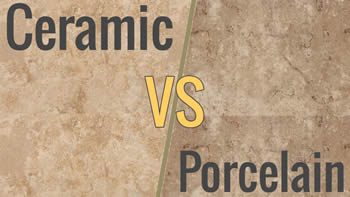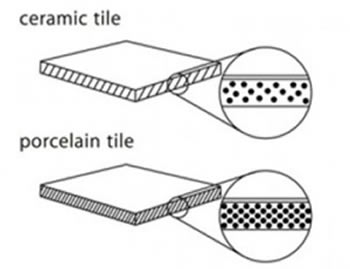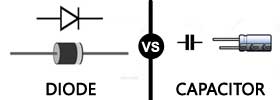Difference between Ceramic and Porcelain Tiles
Key difference: Both ceramic and porcelain tiles are made from clay, sand, and other naturally occurring materials. Porcelain tiles are a specific type of ceramic tiles that have a higher desity and are hence more durable.
 Both ceramic and porcelain tiles are made from clay, sand, and other naturally occurring materials. These materials are then used to make a solution with the required color added to it. The solution is then made into the shape and pattern of the tile. The ceramic and porcelain tiles are then baked in a kiln at the required temperature and for the required duration of time as required for the materials used in the tile.
Both ceramic and porcelain tiles are made from clay, sand, and other naturally occurring materials. These materials are then used to make a solution with the required color added to it. The solution is then made into the shape and pattern of the tile. The ceramic and porcelain tiles are then baked in a kiln at the required temperature and for the required duration of time as required for the materials used in the tile.
However, while the ceramic and porcelain tiles are similar at their core, they are not exactly the same. The term ‘ceramic tiles’ has a much larger scope then porcelain tiles; in fact it can be said that porcelain tiles are a specific type of ceramic tiles. Ceramic tiles can be made from earthenware, stoneware and even porcelain.
Additionally, there are certain traits that differentiate porcelain from other ceramic tiles. Porcelain tiles are usually fired at a higher temperature and a greater pressure, thus making them denser and harder than other ceramic tiles. The clay used to make porcelain tile is usually more refined and purified, thus allowing it to be pounded more densely.
Porcelain tiles also have a low water absorption rate of less than 0.5 percent, making them less likely to crack and more impervious to stains. It is also this absorption rate that allows the tiles to be labeled as vitrified tiles. The tiles extremely low porosity makes them ideal for locations with extreme moisture levels or humidity, as well as for locations with freezing and thawing conditions. Other ceramic tiles cannot usually be used in these locations as they have a tendency to absorb the moisture which then freezes inside the tiles. This freezing and thawing causes the tile to expand and results in the tiles cracking.
 Porcelain tiles like all ceramic tiles come with a glazed or unglazed finish. It clay is extremely easy to work with, both porcelain and ceramic tiles are available in a variety of sizes, including as small as one inch to as large as up to 4 feet.
Porcelain tiles like all ceramic tiles come with a glazed or unglazed finish. It clay is extremely easy to work with, both porcelain and ceramic tiles are available in a variety of sizes, including as small as one inch to as large as up to 4 feet.
While there are various different types of ceramic tiles, porcelain tiles are often considered to be a brand name among the rest. The reason for this is that porcelain tiles are classified as part of the ASTM standard C242. In order to be certified as porcelain tiles under this international standard, the porcelain tiles must meet certain requirement.
Comparison between Ceramic and Porcelain Tiles:
|
|
Ceramic Tiles |
Porcelain Tiles |
|
Description |
Ceramic Tiles are tile that are commonly made from earthenware, stoneware and porcelain. |
Porcelain Tiles is a term used in the US for a ceramic mosaic tile or paver that is generally made by dust-pressing and of a composition yielding a tile that is dense, fine-grained, and smooth, with sharply-formed face, usually impervious. |
|
Material |
Ceramics such as earthenware, stoneware and porcelain. |
Porcelain |
|
Core material |
Clay |
Clay |
|
Uses |
Floor, walls, roofs |
Floor, walls |
|
Strength |
Softer |
Harder |
|
Flexibility |
Less Flexible |
More Flexible |
|
Life |
Shorter lasting when compared to porcelain tiles. |
Longer lasting |
|
Moisture |
Varied depending on materials and process used |
Low moisture absorption rate |
|
Crack |
Depends on the materials and process used. Some less likely to crack then others. |
Less likely to crack |
|
Staining |
Depends on the materials and process used. Some less likely to stain then others. |
Less likely to stain |
|
Cutting |
Easier to cut, as it is often more porous |
Harder to cut. Requires a wet saw, as it is denser. |
|
Colors |
Can be varied depending on the material and paint used. |
The colors are generally clear and bright. |
|
Cost |
Depends on type, but generally cheaper |
Generally more expensive than regular ceramic |
|
Ideal for |
Varied weather conditions |
Cold-weather climates where freeze/thaw conditions |
Reference: Wikipedia (Tile, Porcelain Tile), BHG, Tal, Floorology, The Spruce Image Courtesy: youtube.com, klynstone.com









Add new comment